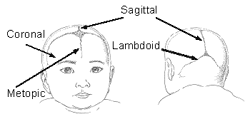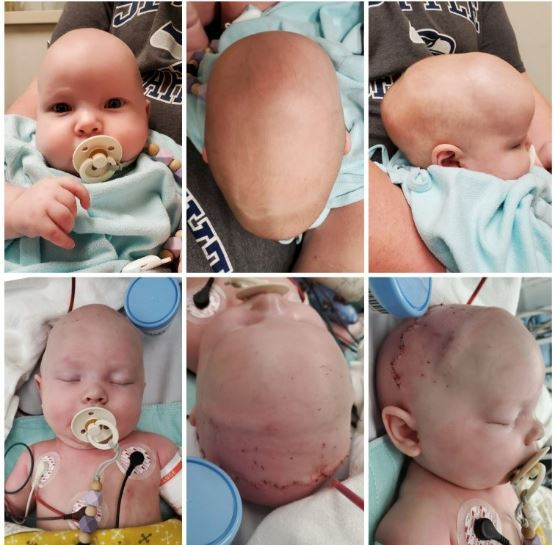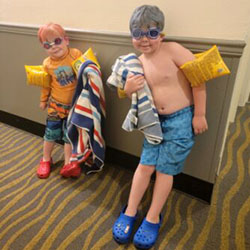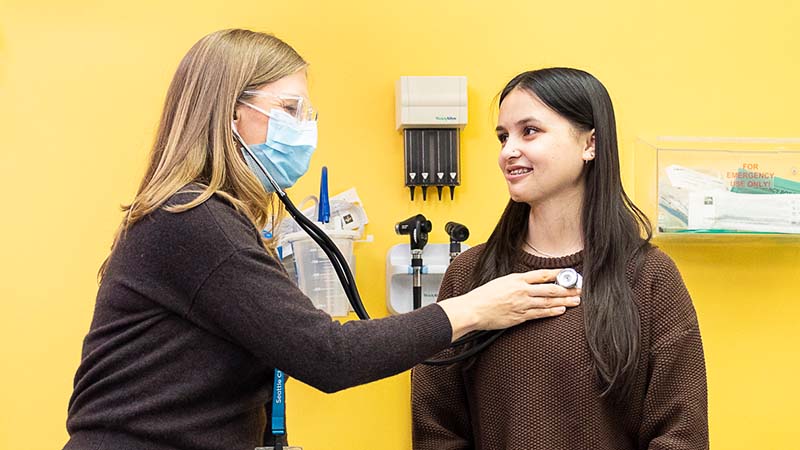Craniosynostosis
Contact the Craniofacial Center
What is craniosynostosis?
Craniosynostosis (kray-nee-o-sin-os-TOE-sis) is when 1 or more of the soft fibrous seams (sutures) in a baby's skull close earlier than normal. Cranio means skull, and synostosis means the sutures are fused or stuck together.
These cranial sutures are between the bone plates in a baby's skull. They allow the baby's head to come through the birth canal. After birth, they let the skull get bigger and make room for brain growth.
Over time, the sutures close and connect the skull bones. The different cranial sutures close at different times, starting at about 3 to 9 months with the metopic suture with the other sutures closing in adulthood.
When these seams close (fuse) too early, it changes the shape of your baby's skull. This can increase pressure in the skull and hurt brain development.
Most often craniosynostosis involves the suture. But it can affect other sutures, such as the , or .
 Drawn by Raymond Sze
Drawn by Raymond Sze
This diagram shows the sutures most often affected. Craniosynostosis of the sagittal suture is the most common type.
What causes craniosynostosis?
Doctors do not know exactly what causes craniosynostosis. Babies are often born with it (it’s congenital). You are likely to notice an unusual shape to your baby's head at birth or soon after.
Most children with craniosynostosis have only 1 fused suture (single-suture craniosynostosis). Otherwise, they are healthy.
If a child has more than 1 fused suture, their craniosynostosis may be part of a genetic condition, such as Crouzon syndrome, Apert syndrome, Saethre-Chotzen syndrome, Muenke syndrome or Pfeiffer syndrome. Children with these have other medical conditions in addition to craniosynostosis.
Craniosynostosis care at Seattle Children's
What is craniosynostosis? (Video 3:27) | Part 2 of 6
In this video, Dr. Carrie Heike explains how the different types of craniosynostosis affect a baby’s skull. The shape of the skull depends on which suture is closed.
What are the symptoms of craniosynostosis?
The first sign of craniosynostosis is an unusual head shape. The shape depends on which soft fibrous seam (suture) in the skull is closed. In mild cases, you and your doctor may not notice it right away.
Other signs and symptoms include:
- The soft spot on your baby's head (fontanelle) disappears early or bulges
- A raised ridge develops along the fused sutures in the skull
Other changes happen depending on which of the cranial sutures grow together. For example, a fused suture may cause a baby's face to appear slightly twisted.
How is craniosynostosis diagnosed?
In rare cases, we can see the fused suture during a routine . Learn more about how prenatal counseling can help you prepare.
More often, doctors diagnose craniosynostosis in the first weeks of life. The doctor will examine and measure your child's head. The shape of their head will help the doctor tell which cranial sutures have grown together. The physical exam and measurement may be all that is needed to diagnose your baby’s condition.
A of your child's head confirms the diagnosis. This also helps us plan the best treatment for your child.
Your child may also have to find out if their craniosynostosis is part of a genetic syndrome.
-
A diagnosis of craniosynostosis: What now?
In this video, our expert doctors share how craniosynostosis is diagnosed. They also explain our team approach to the best care for your child.
-
Diagnosing genetic syndromes
Our Craniofacial Genetics Clinic does testing to find if your child has a craniosynostosis syndrome, such as:
Knowing if your baby’s craniosynostosis is part of a syndrome helps us give your child the best care.
Our team includes geneticists and genetic counselors. They can advise you about the possible benefits of genetic testing and explain the results of genetic tests. Understanding your child’s condition can help you make informed decisions about their treatment.
How is craniosynostosis treated?
The main treatment for craniosynostosis is surgery to make sure your child’s brain has enough room to grow.
Surgeons expand and reform your child’s cranial bones. An experienced craniofacial plastic surgeon and a neurosurgeon work as a team in the operating room. Surgery helps the skull grow into a more typical shape and prevents a buildup of pressure on the brain.
Our doctors carefully assess your baby and explain the different surgeries. We work with you to decide the best for your child.
Surgery recommendation depends on suture and baby’s age
Our recommended treatment depends on which suture in your child’s skull is affected. Their age also matters. We tailor care to your child and family. If only 1 suture is fused, most children need only 1 surgery.
-
Babies with a fused sagittal or lambdoid suture
For babies with a fusion of the or structure, the options depend on their age.
For babies younger than 4 months we offer:
- Endoscopic strip craniectomy, followed by helmet therapy to mold the skull
- Open cranial vault reconstruction
See how the open cranial vault reconstruction and endoscopic procedures compare.
For babies older than 4 months, we recommend open cranial vault reconstruction. Open surgery is best for older babies because skull growth slows at 5 months of age, and helmet therapy to reshape the skull is less effective.
-
Babies with a fused metopic or coronal suture
We often recommend open fronto-orbital advancement for babies with a fused or suture. This surgery takes place when your baby is 9 to 12 months, depending on which suture is fused.
For babies 4 months or younger with a single fused metopic or coronal suture, endoscopic strip craniectomy may also be an option. But there is a greater chance that they will need open surgery later. We partner with you to make a decision that is best for your family.
-
Babies with fused sutures caused by a genetic syndrome
Babies with multiple fused sutures or those with genetic syndromes usually need a series of operations to repair the fused suture and treat other health conditions. Learn about surgery for children with craniofacial syndromes.
Surgery Options for Craniosynostosis
-
Endoscopic strip craniectomy
- During this operation, surgeons use a thin, lighted tube with a camera and small tools attached (endoscope).
- The craniofacial plastic surgeon makes 2 small cuts (incisions) in the top of your baby's head. Each cut is about 1 inch (3 cm).
- Working together, the plastic surgeon and neurosurgeon remove bone but do not reshape your baby’s skull.
- After the surgery, your baby wears a helmet for several months. The helmet molds their head to a shape that allows for normal brain growth.
See details on endoscopic strip craniectomy and helmet therapy.
-
Open cranial vault reconstruction
We use open cranial vault reconstruction to repair a fused structure when the baby is 3 to 6 months old. We do surgery on the structure when a baby is 9 to 12 months old.
- Open cranial vault reconstruction starts by making a zig-zag cut (incision) over the top of baby’s head. The incision goes from one side of the temple to the other.
- The plastic surgeon separates the skin and other soft tissue from the bone underneath.
- Next, the plastic surgeon marks a pattern of bone cuts that will allow the skull shape to change as the brain grows.
- The neurosurgeon makes small holes in the skull. The surgeons carefully separate the coating of the brain (dura) from the bone.
- The plastic surgeon reshapes the bone.
- Sometimes surgeons use plates and screws to hold the shape during healing. These dissolve completely in 1 to 2 years. Rarely, small surgical wires are used for added strength. These do not dissolve.
- Most babies spend 3 to 5 nights in the hospital, including 1 night in the intensive care unit (ICU).
After surgery, your baby's brain has more room to grow and their skull has a more typical shape. Your child does not need a helmet to shape their head after surgery.

Finnley before (top) and after (bottom) open cranial vault reconstruction at Seattle Children's to give his brain more room to grow.
-
Comparing open cranial vault reconstruction and endoscopic strip surgery
This video compares and .
Both options are available for babies up to 4 months old who have a single fused sagittal or lambdoid suture.
OPEN CRANIAL VAULT SURGERY ENDOSCOPIC STRIP CRANIECTOMY 3 to 5 hours in surgery. 1 to 2 hours in surgery. Likely to need a blood transfusion. Less likely to need a blood transfusion. Hospital stay of 3 to 5 days, including 1 in intensive care unit (ICU). Hospital stay of 2 days, including 1 in ICU. Larger scar, but it is usually completely covered by hair within months. Less scarring. No need for a helmet after surgery. After surgery, baby wears a soft helmet for up to 1 year to change their head shape. Frequent check-ups with the helmet molding team to adjust helmet for up to a year. We work with a molding company that has offices across the United States. -
Fronto-orbital advancement
We recommend for babies with metopic and unilateral coronal synostosis. We do this surgery when your baby is 9 to 12 months old, depending on which suture is fused.
- A plastic surgeon and a neurosurgeon work together to move and reshape your baby’s forehead and the upper part of their eye sockets.
- The operation creates more space for your baby’s brain and more protection for their eyes.
- To hold the cranial bone in its new shape until it heals, the surgeon may use screws and plates that absorb into the body over time.
- The operation takes 4 to 5 hours.
- Most babies stay in the hospital 3 to 4 days, including 1 day in the ICU.
Read more about fronto-orbital advancement.
This video explains how fronto-orbital advancement surgery can repair a metopic suture or a coronal suture on 1 side of a baby’s head (unilateral coronal).
What to Expect on Surgery Day
While your child is in the operating room, you will get updates every couple of hours. We give you a pager to carry while you are waiting. When surgery is done, the surgeon will talk to you in person.
See details on how to prepare, what to expect and how to care for your child after surgery.
-
Care for baby and parents during surgery
This video explains what to expect on your child's craniofacial surgery day and how we make the process easier for our patients and their families.
Why choose Seattle Children's for craniosynostosis care?
Most families have never heard of craniosynostosis before their child is born with it. Our craniofacial team is among the most experienced in the world. We have been caring for children with craniosynostosis since 1978. Each year we see more than 400 children with craniosynostosis. That includes more than 150 with complex syndromes.
Many of our patients are babies who are newly diagnosed. We also care for children who received their early treatment at another hospital.
We will create a personalized plan of care for your child. Our center has experts in every field your child might need — from craniofacial and to pediatric neurosurgeons and plastic surgeons. These specialists work together to diagnose and treat your child.
Our Craniofacial Genetics Clinic can test for changes in that might cause your baby’s craniosynostosis. Diagnosing the specific syndrome helps us give your child the best care.
Our team meets weekly to discuss complex patient cases and decide on the best care for each child. We work together and with you and your family’s doctor to coordinate your child’s care.
 "Our surgeons let us know that our sons’ skulls are perfect and rock-solid. They live such normal lives, and you would never be able to tell they had these major surgeries.”
"Our surgeons let us know that our sons’ skulls are perfect and rock-solid. They live such normal lives, and you would never be able to tell they had these major surgeries.”
- Kali Dempsey, whose sons Finnley and Ronan have had surgery for craniosynostosis at Seattle Children's
-
Specialists to cover all your child’s needs
Your child’s treatment team is managed by a “hub” consisting of a craniofacial pediatrician, craniofacial nurse specialist, family service coordinator and .
Your child’s team also will include a craniofacial plastic surgeon, and a pediatric neurosurgeon. If needed, your child may receive care from other experts in our center, including a surgical orthodontist, orthotist, dietitian, ophthalmologist and otolaryngologist.
We care for care for your child’s physical, emotional and comfort needs. Read more about the supportive care we offer.
-
We support your whole family
A diagnosis of craniosynostosis can be scary. We take time to explain your child’s condition and answer all your questions.
We help you fully understand your treatment options, so you can make the choices that are right for your family. Our social workers support your child and family through the challenges of this condition.
Seattle Children’s provides craniofacial care for children living in Washington, Alaska, Montana and Idaho. We also care for patients from across the globe. This experience has helped us develop systems to provide outstanding, personal care at a great distance.
We help our patients transition to care from providers for adults when the time is right. See Transition to Adult Care - Craniosynostosis in Your Family (PDF).
-
Research to improve care
Our team has created a clinical care pathway that guides your child’s treatment from diagnosis onward. It is based on the research evidence about what is most effective. This gives doctors a blueprint for giving the best care and makes it easier to improve that care.
As a founding member of the Synostosis Registry Group (SynRG), we conduct multicenter research on craniosynostosis. Dr. Amy Lee and Dr. Craig Birgfeld lead this work at Seattle Children’s.
We are building a library of 3D images to study the best surgical approach for different types of craniosynostosis. The images show changes in facial and skull shape before and after surgery.
Our research is helping us to:
- Better understand the genetic causes of craniosynostosis
- Study how the condition affects learning and behavior
- Build a library of 3D images to find out which surgical approaches lead to the most improvement for a specific syndrome
Read more about:
Contact Us
If you would like an appointment, ask your healthcare provider to refer you. If you have a referral, call 206-987-2208 to make an appointment. For a second opinion or more information, contact the Craniofacial Center at 206-987-2208.
Providers, see how to refer a patient. Our fax number is 206-985-3370.
Paying for Care
Learn about paying for care at Seattle Children’s, including insurance coverage, billing and financial assistance.


